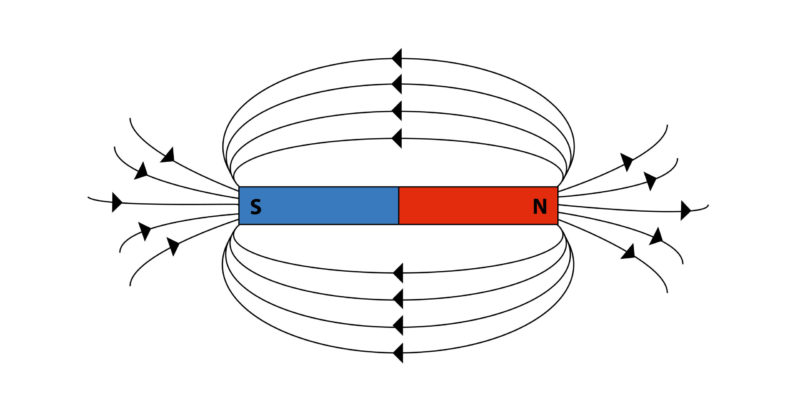We explain what the magnetic field is, how they originate and the types that exist. Also, what are its characteristics and measurement.
What is a magnetic field?
When we talk about a magnetic field, we are referring to a mathematical representation of how magnetic forces are distributed in space around a magnetic source.
The magnetic field is in the region surrounding the source of magnetic energy and it is in this region where the energy can interact with other elements sensitive to magnetism, such as ferromagnetic metals.
Magnetic fields are always dipolar, that is, they have a north and a south pole , that is, one positive and one negative. They are described in a vectorial way, that is to say, as a set of forces endowed with direction and magnitude , representable by means of vectors on a grid. These vectors behave like compasses and their magnitude of response depends on the intensity of the magnetic force.
As long as there is a source of magnetic energy, there will be a magnetic field to describe how magnetic forces act. The interaction between these fields in electrical devices (such as transformers) is a subject of study in the science of magnetic circuits.
history of magnetic fields

Since ancient times, the existence of magnetism and the forces of attraction or repulsion that are generated between magnets have been known. But it was not until the 19th century that the relationship between magnetism and electricity became evident and was formally studied.
Initially only the magnetism of iron (ferromagnetism) was known until in 1820 the Danish scientist Hans Christian Oersted demonstrated the effect that electricity had on a compass and discovered what Maxwell's equations would describe years later.
How does a magnetic field originate?
For a magnetic field to exist, there must be a source of magnetic energy , that is, a magnet or electromagnet, or a moving electric current.
The correlation between electricity and magnetism is described in Ampère's Law and Maxwell's equations. The presence of a magnetic field can be detected using a magnetometer .
Lorenz Force Law
The so-called Lorentz Force is a way of defining magnetic fields mathematically , since said force is the one exerted by a magnet or an electric current on a region of space where a punctual electric charge (q) moves experiencing the effects of a force proportional and perpendicular to the velocity (v) and the field (B). This load will perceive a force whose module can be calculated according to this equation:
|F| = |q|.|v|.|B|. sin(?).
where F is the magnetic force, v is velocity, B is the magnetic field, and ? is the angle that the velocity of charge q makes with respect to the magnetic field B.
Types of magnetic fields

Magnetic fields are classified according to their source of creation, in:
- Magnet Magnetic Fields . They are those created naturally by a magnet or magnetized metal , caused by the movement of electrons around the atomic nucleus and also on its own axis, in a rotation known as spin .
- Current Magnetic Fields . They are those generated by the moving charges of an electric current, as in electromagnets: an electric charge is made to circulate through a metal piece and it is immediately magnetized, generating a field around it.
magnetic field lines
Magnetic field lines or induction lines are a way of graphically representing the action of magnetic forces in space . They are lines that never cross and that are crowded in the regions in which the field is more intense, since the density of lines is synonymous with the intensity of the field.
These lines are the ones that are then represented mathematically as vectors , but in reality they can be verified by means of the simple experiment of placing a sheet of white paper on a magnet and pouring iron filings on the paper, to observe the way in which they are arranged visually. around both poles.
Intensity of magnetic fields

Magnetic field strength refers to two forms of magnitude of magnetic forces:
- Magnetic excitation or H field . Understanding magnetism in a very similar way to electricity, it describes how intense the energy of the magnetic field is in a precise and specific region of it. It is determined by the relationship of the field to its electrical sources.
- Magnetic induction or B field . Considered the true measurement of the magnetic field, it measures the amount of magnetic flux per unit area in a given region of the field. That is, it studies the field in terms of its effects on charges.
How are magnetic fields measured?
Being a vector quantity, the measurement of magnetic fields includes both the intensity and the direction of the field.
For direction there are simple measurement mechanisms such as the compass : where the needle points will be the pole, just as it happens on the planet with the terrestrial north pole .
For intensity, on the other hand, in the past the magnetometer was used , capable of measuring the force felt by an electron when moving through the magnetic field.
The first devices of this type appeared in the 19th century, but in 1988 they were improved by the discovery of giant magnetoresistance.
The intensity of the field is measured, according to the SI in Teslas (T) , in honor of the Czech scientist who studied electricity and magnetism, or in Gauss (G) depending on the size of the field to be measured.
Direction of a magnetic field

The direction of the magnetic field is described by lines of force or vectors that indicate the direction in which magnetic forces push a charge in the field.
In fact, the variables B and H of the intensity of the field are both vectors , they have a magnitude, a direction and a sense that are variable according to the proximity of the field region with respect to the magnetic source or pole.
magnetic field in living things
Known as bioelectromagnetism, this phenomenon in living beings of different types refers to the creation of magnetic fields within their bodies or the interaction of some parts of them with the Earth's magnetic field.
Pigeons and many migratory animals have sensitivity to detect the earth's magnetic field and know where to migrate depending on the season or time.
In addition, the electrical action of the nerves on the muscles of the body and how the transmission of ions and other magnetic substances allows the nerve connection between neurons to be carried out .
Earth's magnetic field

The Earth has a huge magnetic field, known as the magnetosphere or geomagnetic field . It is caused by the constant movement of the planet's ferromagnetic metal core (mainly iron and copper ) due to the Earth's rotation.
It fulfills very important roles for the electrical balance of the world , such as protecting us from the solar wind and rejecting other forms of electromagnetism that could be harmful to life (cosmic rays).
In addition, the compasses we use for navigation react to this enormous field, always pointing north.
The above content published at Collaborative Research Group is for informational and educational purposes only and has been developed by referring reliable sources and recommendations from technology experts. We do not have any contact with official entities nor do we intend to replace the information that they emit.
MA student of the TransAtlantic Masters program at UNC-Chapel Hill. Political Science with a focus on European Studies. Expressed ideas are open to revision. He not only covers Technical articles but also has skills in the fields of SEO, graphics, web development and coding. .
Leave a reply
Your email address will not be published. Required fields are marked *Recent post

Sport: What Is It, Types, Risks, Features, Characteristics and Examples

Dogs: Emergence, Features, Characteristics, Feeding and Breeds

Story: Definition, Elements, Structure, Features and Characteristics

